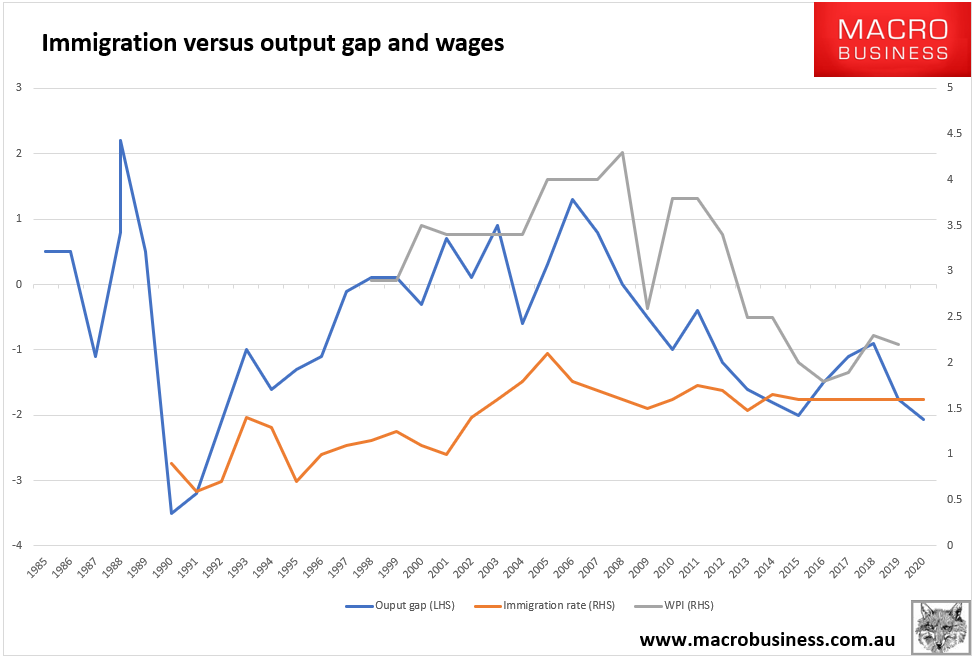The carcass of COVID-19 is barely cold and here it comes. Domain leads us off:
Australia’s dependence on immigration to grow the economy is about to be sorely tested.
…Over the past decade, the nation’s permanent population has grown by 3.7 million to more than 25 million. Of that increase, 60 per cent was due to net migration.
That extra 2.2 million people have been an economic powerhouse, requiring homes, cars, food and every day goods and services while also contributing fresh skills to the jobs market.
…The government is now expecting net overseas migration – which was forecast to reach 271,000 in 2019-20 – to be 30 per cent lower. Next year, the drop is tipped to be 85 per cent.
Labor is staking out its territory with Kristina Keneally out of the blocks, also as Domain:
Our economic recovery must help all Australians get back on their feet, and to do that we need a migration program that puts Australian workers first.
Governments of all stripes have relied on high levels of migration to boost population to fuel economic growth. Arguably, at times this has been a lazy approach. Letting lots of migrants come to Australia is an easier way to drive economic growth than increasing productivity or investing in skills and training.
…In a cynical move, Morrison capped permanent migration at 160,000 a year and claimed it as a “congestion busting” measure, but at the same time allowed temporary migration to soar to historically high levels.
Unlike permanent visas, temporary visas are uncapped. As at June 2019 there were 2.1 million temporary visa holders here. Australia hosts the second largest migrant workforce in the OECD, second in total number only to the US.
…Temporary migrants make up a larger part of the labour market than most Australians might realise. Migrant workers don’t just pick fruit: one in five chefs, one in four cooks, one in six hospitality workers, and one in 10 nursing support and personal care workers in Australia hold a temporary visa.
As economist Stephen Koukoulas pointed out before the crisis, there are 725,000 unemployed and 1,150,000 underemployed Australians who, with the right training, would love to have these roles. “It explains why wages growth is dead – too many temporary work visas for this stage of the economic cycle,” Koukoulas said.
It’s not just the number of temporary migrants that affects wages. The Coalition’s migration policies actually encourage employers in certain geographic areas and some industries to pay temporary migrants a much lower wage than what Australians would earn doing the same job.
Labor has been just as bad. Bill Shorten’s one million parental visas electoral platform was suicidal policy. Hopefully this signals an ALP regime change.
The Coalition is also staking out its position, at the AFR:
Minister Tehan is being asked about whether Australia would consider allowing foreign students to return to Australia before international travel resumes more generally.
“It is something we would look at,” he said.
Mr Tehan said foreign students supported 250,000 jobs in Australia.
Yeh, but there are 950k of them, most of whom will work in one form or another. You do the math.
The lobbying has started, at the AFR:
[Morrison] said the migration drop was not expected to be permanent and the forecast was uncertain because the COVID-19 situation had improved significantly compared with six weeks ago.
Australian National University demographer Liz Allen said immigration was crucial to the government’s income tax base.
“With fewer migrants helping build and maintain the economy by providing needed skills … the national budget will take an enormous hit in the short to medium term.”
With respect, how would Ms Allen know? Her PhD is in devices and obesity.
The truth is clear. We can save some pain for the education and housing sectors by ramping up immigration. But that will come at the cost of low wage growth for everybody as the endless output gap (having too much supply versus demand) yawns still further:

As well, given the parlous state of public budgets, we will never see the investment needed to bring infrastructure up to speed, even versus the last wave of crush-loading population growth let alone the next. So, we can be certain of falling living standards.
And it will, of course, deliver more pressure on house prices, which is kicking Aussie youth square in the nuts, again, just as we should be making policy that offers recompense for their greater sacrifice in addressing the pandemic.
The alternative to immigration-led growth is not no growth. It is a broader macro canvas than sectional interests and partial analysis.
It is that because domestic demand is a little lower, then the currency will fall further, and demand in tradeable industries will be a little higher. That lower Australian dollar also delivers immense budget gains.
This will take time to get traction, but get traction it will, especially as the government seeks to repatriate critical manufacturing supply chains, in the national interest.
Conversely, if mass immigration is restored then that project will become damn near impossible as the currency and input costs are higher, not in the national interest.
And China will gain more control.
The macro path ahead for the next phase of Australian growth is clear. Lower immigration.
All that’s up for grabs is whether or not we take it.

